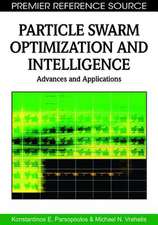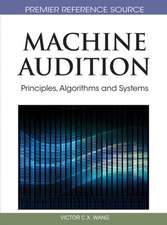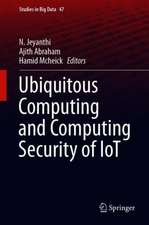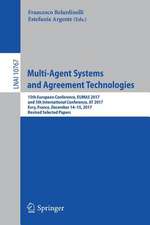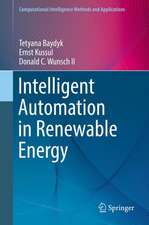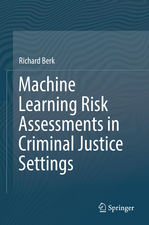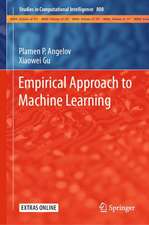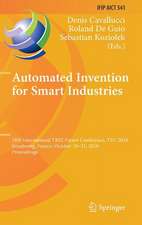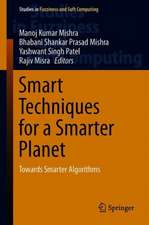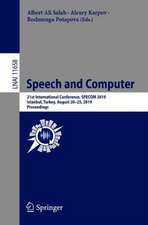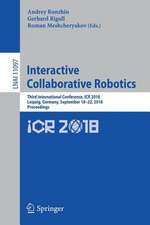Speech and Computer: 18th International Conference, SPECOM 2016, Budapest, Hungary, August 23-27, 2016, Proceedings: Lecture Notes in Computer Science, cartea 9811
Editat de Andrey Ronzhin, Rodmonga Potapova, Géza Némethen Limba Engleză Paperback – 13 aug 2016
The 85 papers presented in this volume were carefully reviewed and selected from 154 submissions.
Din seria Lecture Notes in Computer Science
- 20%
 Preț: 1053.72 lei
Preț: 1053.72 lei - 20%
 Preț: 337.82 lei
Preț: 337.82 lei - 20%
 Preț: 339.43 lei
Preț: 339.43 lei - 20%
 Preț: 449.99 lei
Preț: 449.99 lei - 20%
 Preț: 238.01 lei
Preț: 238.01 lei - 20%
 Preț: 337.82 lei
Preț: 337.82 lei - 20%
 Preț: 438.69 lei
Preț: 438.69 lei -
 Preț: 446.28 lei
Preț: 446.28 lei - 20%
 Preț: 341.10 lei
Preț: 341.10 lei - 20%
 Preț: 148.66 lei
Preț: 148.66 lei - 20%
 Preț: 310.26 lei
Preț: 310.26 lei - 20%
 Preț: 256.27 lei
Preț: 256.27 lei - 20%
 Preț: 640.52 lei
Preț: 640.52 lei - 17%
 Preț: 427.22 lei
Preț: 427.22 lei - 20%
 Preț: 650.20 lei
Preț: 650.20 lei - 20%
 Preț: 307.71 lei
Preț: 307.71 lei - 20%
 Preț: 1067.33 lei
Preț: 1067.33 lei - 20%
 Preț: 587.17 lei
Preț: 587.17 lei -
 Preț: 378.43 lei
Preț: 378.43 lei - 20%
 Preț: 334.54 lei
Preț: 334.54 lei - 15%
 Preț: 435.36 lei
Preț: 435.36 lei - 20%
 Preț: 607.39 lei
Preț: 607.39 lei - 20%
 Preț: 538.29 lei
Preț: 538.29 lei -
 Preț: 389.48 lei
Preț: 389.48 lei - 20%
 Preț: 326.98 lei
Preț: 326.98 lei - 20%
 Preț: 1404.34 lei
Preț: 1404.34 lei - 20%
 Preț: 1016.88 lei
Preț: 1016.88 lei - 20%
 Preț: 575.04 lei
Preț: 575.04 lei - 20%
 Preț: 575.48 lei
Preț: 575.48 lei - 20%
 Preț: 579.12 lei
Preț: 579.12 lei - 20%
 Preț: 757.61 lei
Preț: 757.61 lei - 15%
 Preț: 576.20 lei
Preț: 576.20 lei - 17%
 Preț: 360.19 lei
Preț: 360.19 lei - 20%
 Preț: 504.57 lei
Preț: 504.57 lei - 20%
 Preț: 172.69 lei
Preț: 172.69 lei - 20%
 Preț: 369.12 lei
Preț: 369.12 lei - 20%
 Preț: 350.92 lei
Preț: 350.92 lei - 20%
 Preț: 581.57 lei
Preț: 581.57 lei -
 Preț: 407.85 lei
Preț: 407.85 lei - 20%
 Preț: 592.06 lei
Preț: 592.06 lei - 20%
 Preț: 757.61 lei
Preț: 757.61 lei - 20%
 Preț: 819.86 lei
Preț: 819.86 lei - 20%
 Preț: 649.49 lei
Preț: 649.49 lei - 20%
 Preț: 347.62 lei
Preț: 347.62 lei - 20%
 Preț: 309.90 lei
Preț: 309.90 lei - 20%
 Preț: 122.89 lei
Preț: 122.89 lei
Preț: 352.21 lei
Preț vechi: 440.27 lei
-20% Nou
Puncte Express: 528
Preț estimativ în valută:
67.44€ • 69.49$ • 56.60£
67.44€ • 69.49$ • 56.60£
Carte tipărită la comandă
Livrare economică 22 februarie-08 martie
Preluare comenzi: 021 569.72.76
Specificații
ISBN-13: 9783319439570
ISBN-10: 331943957X
Pagini: 749
Ilustrații: XVIII, 731 p. 197 illus.
Dimensiuni: 155 x 235 x 38 mm
Greutate: 1.03 kg
Ediția:1st ed. 2016
Editura: Springer International Publishing
Colecția Springer
Seriile Lecture Notes in Computer Science, Lecture Notes in Artificial Intelligence
Locul publicării:Cham, Switzerland
ISBN-10: 331943957X
Pagini: 749
Ilustrații: XVIII, 731 p. 197 illus.
Dimensiuni: 155 x 235 x 38 mm
Greutate: 1.03 kg
Ediția:1st ed. 2016
Editura: Springer International Publishing
Colecția Springer
Seriile Lecture Notes in Computer Science, Lecture Notes in Artificial Intelligence
Locul publicării:Cham, Switzerland
Cuprins
Automatic Speech Recognition based on Neural Networks.- Machine Processing of Dialogue States; Speculations on Conversational Entropy.- Speech Recognition Challenges in the Car Navigation Industry.- A Comparison of Acoustic Features of Speech of Typically Developing Children and Children with Autism Spectrum Disorders.- A Deep Neural Networks (DNN) Based models for a Computer Aided Pronunciation Learning System.- A Linguistic Interpretation of the Atom Decomposition of Fundamental Frequency Contour for American English.- A Phonetic Segmentation Procedure Based on Hidden Markov Models.- A Preliminary Exploration of Group Social Engagement Level Recognition in Multiparty Casual Conversation.- An Agonist-Antagonist Pitch Production Model.- An Algorithm for Phase Manipulation in a Speech Signal.- An Exploratory Study on Sociolinguistic Variation of Russian Everyday Speech.- Adaptation of DNN Acoustic Models using KL-divergence Regularization and Multi-Task Training.- Advances in STC Russian Spontaneous Speech Recognition System.- Approaches for Out-of-Domain Adaptation to Improve Speaker Recognition Performance.- Assessment of the Relation Between Low-Frequency Features and Velum Opening by Using Real Articulatory Data.- Automatic Summarization of Highly Spontaneous Speech.- Backchanneling via Twitter Data for Conversational Dialogue Systems.- Bio-Inspired Sparse Representation of Speech and Audio Using Psychoacoustic Adaptive Matching Pursuit.- Combining Atom Decomposition of the F0 Track and HMM-based Phonological Phrase Modelling for Robust Stress Detection in Speech.- Comparative analysis of classifiers for automatic language recognition in spontaneous speech.- Comparison of Retrieval Approaches and Blind Relevance Feedback Methods within the Czech Speech Information Retrieval.- Convolutional Neural Network in the Task of Speaker Change Detection.- Design of a Speech Corpus for Research on Cross-Lingual Prosody Transfer.- Designing High-Coverage Multi-Level TextCorpus for Non-Professional-Voice Conservation.- Designing Syllable Models for an HMM based Speech Recognition System.- Detecting Filled Pauses and Lengthenings in Russian Spontaneous Speech using SVM.- Detecting Laughter and Filler Events by Time Series Smoothing with Genetic Algorithms.- Detecting State of Aggression in Sentences using CNN.- DNN-based Acoustic Modeling for Russian Speech Recognition Using Kaldi.- DNN-Based Duration Modeling for Synthesizing Short Sentences.- Emotional Speech of 3-Years Old Children: Norm-Risk-Deprivation.- Ensemble Deep Neural Network based Waveform-Driven Stress Model for Speech Synthesis.- Evaluation of Response Times on a Touch Screen using Stereo Panned Speech Command Auditory Feedback.- Evaluation of the Speech Quality During Rehabilitation after Surgical Treatment of the Cancer of Oral Cavity and Oropharynx based on a Comparison of the Fourier Spectra.- Experiments with One-Class Classifier as a Predictor of Spectral Discontinuities in Unit Concatenation.- Exploring GMM-derived Features for Unsupervised Adaptation of Deep Neural Network Acoustic Models.- Feature Space VTS with Phase Term Modeling.- Finding Speaker Position Under Difficult Acoustic Conditions.- Fusing Various Audio Feature Sets for Detection of Parkinson's Disease from Sustained Voice and Speech Recordings.- HAVRUS Corpus: High-speed Recordings of Audio-Visual Russian Speech.- Human-Smartphone Interaction for Dangerous Situation Detection & Recommendation Generation while Driving.- Improving Automatic Speech Recognition Containing Additive Noise Using Deep Denoising Autoencoders of LSTM Networks.- Improving the Quality of Automatic Speech Recognition in Trucks.- Improving Recognition of Dysarthric Speech Using Severity Based Tempo Adaptation.- Improving Robustness of Speaker Verification by Fusion of Prompted Text-Dependent & Text-Independent Operation Modalities.- Improvements to Prosodic Variation in Long Short-Term Memory based Intonation Models Using Random Forest.- In-document Adaptation for a Human Guided Automatic Transcription Service.- Interaction Quality as a Human-Human Task-Oriented Conversation Performance.- Investigation of Segmentation in i-Vector based Speaker Diarization of Telephone Speech.- Investigation of Speech Signal Parameters Reflecting the Truth of Transmitted Information.- Investigating Signal Correlation as Continuity Metric in a Syllable based Unit Selection Synthesis System.- Knowledge Transfer for Utterance Classification in Low-Resource Languages.- Language Identification using Time Delay Neural Network D-Vector on Short Utterances.- Lexical Stress in Punjabi and its Representation in PLS.- Low Inter-Annotator Agreement in Sentence Boundary Detection and Personality.- LSTM-based Language Models for Spontaneous Speech Recognition.- Measuring Prosodic Entrainment in Italian Collaborative Game-based Dialogues.- Microphone Array Directivity Improvement in Low-Frequency Domain for Speech Processing.- Modeling Imperative Utterances in Russian Spoken Dialogue: Verb-Central Quantitative Approach.- Multimodal Perception of Aggressive Behavior.- On Individual Polyinformativity of Speech and Voice Regarding Speaker's Auditive Attribution (Forensic Phonetic Aspect).- Online Biometric Identification With Face Analysis in Web Applications.- Optimization of Zelinski post-filtering calculation.- Phonetic Aspects of High Level of Naturalness in Speech Synthesis.- Polybasic Attribution of Social Network Discourse.- Precise Estimation of Harmonic Parameter Trend and Modification of a Speech Signal.- Profiling a Set of Personality Traits of a Text's Author: a Corpus-Based Approach.- Prosody Analysis of Malay Language Storytelling Corpus.- Quality Assessment of two Fullband Audio Codecs Supporting Real-Time Communication.- Robust Speech Analysis Based on Source-Filter Model Using Multivariate Empirical Mode Decomposition in Noisy Environments.- Scenarios of Multimodal Information Navigation Services for Users in Cyberphysical Environment.- Scores Calibration in Speaker Recognition Systems.- Selecting Keypoint Detector and Descriptor Combination for Augmented Reality Application.- Semi-automatic Speaker Verification System Based on Analysis of Formant, Durational and Pitch Characteristics.- Speaker-Dependent Bottleneck Features for Egyptian Arabic Speech Recognition.- Speech Acts Annotation of Everyday Conversations in the ORD corpus of Spoken Russian.- Speech Enhancement with Microphone Array Using a Multi Beam Adaptive Noise Suppressor.- Speech Features Evaluation for Small Set Automatic Speaker Verification Using GMM-UBM System.- Speech Recognition combining MFCCs and Image Features.- Sociolinguistic Extension of the ORD Corpus of Russian Everyday Speech.- Statistical Analysis of Acoustical Parameters in the Voice of Children with Juvenile Dysphonia.- Stress, Arousal, and Stress Detector Trained on Acted Speech Database.- Study on the Improvement of Intelligibility for Elderly Speech using Formant Frequency Shift Method.- Text Classification in the Domain of Applied Linguistics as Part of a Pre-editing Module for Machine Translation Systems.- Tonal Specification of Perceptually Prominent Non-Nuclear Pitch Accents in Russian.- Toward Sign Language Motion Capture Dataset Building.- Trade-off Between Speed and Accuracy for Noise Variance Minimization (NVM) Pitch Estimation Algorithm.- Unsupervised Trained Functional Discourse Parser for E-Learning Materials Scaffolding.
Caracteristici
Includes supplementary material: sn.pub/extras

